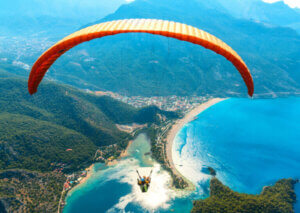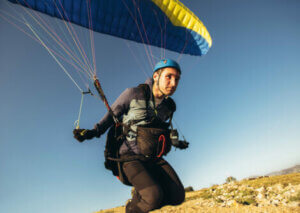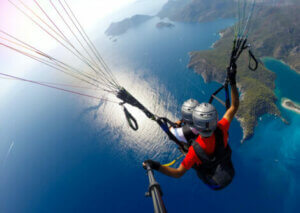Everything You Need to Know About Paragliding

It’s considered a risky or extreme sport, although most instructors and participants say that if you follow the rules, it’s quite safe. Paragliding is a sport where you glide as if you’re using a parachute, but you can fly according to the air currents.
It’s a fairly new sport since it was practiced for the first time in the late 1970s in the French Alps. More precisely, it took place near the village of Mieussy. Those who did this activity were paratroopers who decided to change free falls for a more “pleasant” experience.
It didn’t take long to get the attention of climbers, who found out that paragliding is a new way to descend from mountains once they reached the top. In 1985, the first paragliding school was created in the Alps, and since then it’s become quite popular. Also, the World Air Sports Federation is the organization that oversees this sport.
What equipment do paragliders need?
To begin with, you need a sail or a wing, which is similar to a parachute but specifically designed to glide and maneuver. This wing is tied with long ropes to a chair or harness, so the pilot is well supported during the flight.
In addition, you have to wear a helmet to protect yourself in case of accidents, as well as a basic emergency parachute. As additional equipment, you’ll have a variometer. This tells the vertical speed at all times to know if you are going up or down.
Additionally, many people also carry a GPS to know exactly where they are. If you’re flying in a group, a radio station never hurts to communicate with everyone.

Are there different types of paragliding?
There are different types of paragliding you can do according to the characteristics of the terrain or the weather. Hillside flight is carried out with an updraft of air, while flight in thermals takes advantage of updrafts caused by heating the air.
On the other hand, drag flight is after a traction car “drags” you and releases rope until the pilot rises.
Finally, there’s the paramotor where an engine is added to the aircraft and the flight is no longer just based on air. The engine is on the pilot’s back, and he accelerates with remote control.
Tips for paragliding
Fear is one of the reasons why someone doesn’t dare paraglide. This fear often comes from a lack of information. Therefore, as a first step, we recommend asking a professional about all the doubts you have. Also, stay informed and talk with people in the know, such as experienced instructors and pilots.
Controlling your breathing, relaxing, and “letting yourself go” is the best advice someone can give you before going paragliding. Also, to this, we can add getting a good night’s sleep, not drinking alcoholic beverages, and eating lightly.

As for equipment, you need comfortable and well-fitting shoes so they won’t come off mid-flight. In addition, you need sunglasses, comfortable clothing, and sunscreen. In fact, air currents can also burn your skin.
Paragliding is a unique experience that depends on the weather. So, you need to check the weather conditions to see if you can fly that day. You won’t be able to fly if the wind exceeds 25 miles per hour, or if it’s raining.
Start small and carefully
The first time you try paragliding, you’ll have to be with an instructor. For this, there are two-seater paragliders. After learning the basics, the pilot makes sure that the wing moves and the ride is carried out. If you want more fun and adrenaline after the flight, you can even take a course to become an instructor yourself.
Finally, we recommend that you try paragliding for a special event, or even as an outing with your friends or family. You’ll all have a great time!
It’s considered a risky or extreme sport, although most instructors and participants say that if you follow the rules, it’s quite safe. Paragliding is a sport where you glide as if you’re using a parachute, but you can fly according to the air currents.
It’s a fairly new sport since it was practiced for the first time in the late 1970s in the French Alps. More precisely, it took place near the village of Mieussy. Those who did this activity were paratroopers who decided to change free falls for a more “pleasant” experience.
It didn’t take long to get the attention of climbers, who found out that paragliding is a new way to descend from mountains once they reached the top. In 1985, the first paragliding school was created in the Alps, and since then it’s become quite popular. Also, the World Air Sports Federation is the organization that oversees this sport.
What equipment do paragliders need?
To begin with, you need a sail or a wing, which is similar to a parachute but specifically designed to glide and maneuver. This wing is tied with long ropes to a chair or harness, so the pilot is well supported during the flight.
In addition, you have to wear a helmet to protect yourself in case of accidents, as well as a basic emergency parachute. As additional equipment, you’ll have a variometer. This tells the vertical speed at all times to know if you are going up or down.
Additionally, many people also carry a GPS to know exactly where they are. If you’re flying in a group, a radio station never hurts to communicate with everyone.

Are there different types of paragliding?
There are different types of paragliding you can do according to the characteristics of the terrain or the weather. Hillside flight is carried out with an updraft of air, while flight in thermals takes advantage of updrafts caused by heating the air.
On the other hand, drag flight is after a traction car “drags” you and releases rope until the pilot rises.
Finally, there’s the paramotor where an engine is added to the aircraft and the flight is no longer just based on air. The engine is on the pilot’s back, and he accelerates with remote control.
Tips for paragliding
Fear is one of the reasons why someone doesn’t dare paraglide. This fear often comes from a lack of information. Therefore, as a first step, we recommend asking a professional about all the doubts you have. Also, stay informed and talk with people in the know, such as experienced instructors and pilots.
Controlling your breathing, relaxing, and “letting yourself go” is the best advice someone can give you before going paragliding. Also, to this, we can add getting a good night’s sleep, not drinking alcoholic beverages, and eating lightly.

As for equipment, you need comfortable and well-fitting shoes so they won’t come off mid-flight. In addition, you need sunglasses, comfortable clothing, and sunscreen. In fact, air currents can also burn your skin.
Paragliding is a unique experience that depends on the weather. So, you need to check the weather conditions to see if you can fly that day. You won’t be able to fly if the wind exceeds 25 miles per hour, or if it’s raining.
Start small and carefully
The first time you try paragliding, you’ll have to be with an instructor. For this, there are two-seater paragliders. After learning the basics, the pilot makes sure that the wing moves and the ride is carried out. If you want more fun and adrenaline after the flight, you can even take a course to become an instructor yourself.
Finally, we recommend that you try paragliding for a special event, or even as an outing with your friends or family. You’ll all have a great time!
All cited sources were thoroughly reviewed by our team to ensure their quality, reliability, currency, and validity. The bibliography of this article was considered reliable and of academic or scientific accuracy.
- Clarín – Parapente, un deporte de riesgo que requiere ciertas precauciones – Febrero 2016 – https://www.clarin.com/tips-de-viajes/turismo-aventura-riesgos-precauciones_0_BJWKEpuDmx.html
- Castro Rico G, Trece instrucciones para volar en parapente – El Espectador – Agosto 2018 – https://www.elespectador.com/cromos/estilo-de-vida/trece-instrucciones-para-volar-en-parapente/
This text is provided for informational purposes only and does not replace consultation with a professional. If in doubt, consult your specialist.








